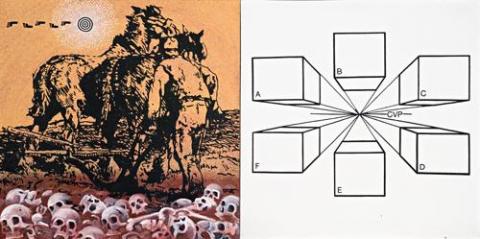THE PLOUGH, 1989
Gordon Bennett
oil on canvas (2)
130.0 x 260.0 cm (overall)
left panel signed, dated and inscribed verso: G Bennett/ ‘The Plough’ 1989/ Oil on Canvas 130 x 260 cms/ (after Hans Heysen/ The Plough/ Charcoal drawing)
right panel signed, dated and inscribed verso: G Bennett/ “The Plough” 1989/ oil on canvas 130 x 260 cms
Bellas Gallery, Brisbane
Private collection, Brisbane
Private collection, Queensland
Gordon Bennett, Bellas Gallery, Brisbane 1989
McLean, I. & Bennett, G., The Art of Gordon Bennett, Craftsman House, Sydney, 1996, pl.16 (illus.)
'If I were to choose a single word to describe my art practice it would be the word question. If I were to choose a single word to describe my underlying drive it would be freedom... Freedom is a practice. It is a way of thinking in other ways to those we have become accustomed to. To be free is to be able to question the way power is exercised, disputing claims to domination. Such questioning involves our 'ethos', our way of being, or becoming who we are. To be free we must be able to question the way our own history defines us.'1
Significantly, Bennett's first investigations into the construction of personal and cultural identity, the power of language and the nature of representation not only coincided with, but were fuelled by the unfolding of Australia's Bicentennial celebrations in 1988. Declared by the Indigenous community as 'a year of mourning', the commemoration prompted Bennett to embark upon a series of paintings, exemplified by the present, which re-presents the story of Australian settlement as one of invasion and genocide. Employing the technique of appropriation so central to the deconstructivist project of postmodernism, in these paintings Bennett borrows images from old social studies and history textbooks and places them in new relationships: '...by recontextualising images subtracted from this grid of Euro-Australian 'self' representation, I attempted to show the constructed nature of history and of identification as arbitrary, not fixed or natural, but open to new possibilities of meaning and identification.'2
Hence, while The Plough 1989 derives from a drawing by iconic Australian landscape artist Hans Heysen, it has been manipulated here to feature fields of bones which, according to Bennett, are the foundation of Australian wealth. Similarly, The Betrayal (Pieces of Silver) and Web of Attrition (which draw their impetus from nineteenth-century colonial paintings), and Terra Nullius and Prologue: They Sailed Slowly Nearer (both based on social history book illustrations) suggest the betrayal, humiliation and killing of Aboriginal people as a result of colonial settlement. In each of these works, the use of dots is equally imbued with dual meaning - referring on the one hand to the unifying dot matrix of photographic reproduction in the textbook images appropriated, and on the other, to the technique so characteristic of Aboriginal Western Desert painting. In his endeavour to create fields of disturbance which not only encourage but necessitate the viewer re-reading the image (and the mythology), Bennett moreover undermines the prevailing 'colonialist' mode of representation by foregrounding perspective, and thus exposing the ideological framework that exists between the observing subject and the observed object. The diagram on the right with converging lines towards a central vanishing point further articulates this concern with the power inherent in the Eurocentric technique of creating an illusion of depth. As Bennett elucidates, '...By disrupting this field of representation, I hoped to implicate the observing subject in the production of meaning, not in order to affirm the subject but in order to stimulate thought and the possibility of exceeding the historical parameters that frame it.'3
1. Bennett, G., 'The manifest toe' in McLean, I. & Bennett, G., The Art of Gordon Bennett, Craftsman House, Sydney, 1996, pp.10-12
2. ibid., p.43
3. ibid., p.35
VERONICA ANGELATOS
